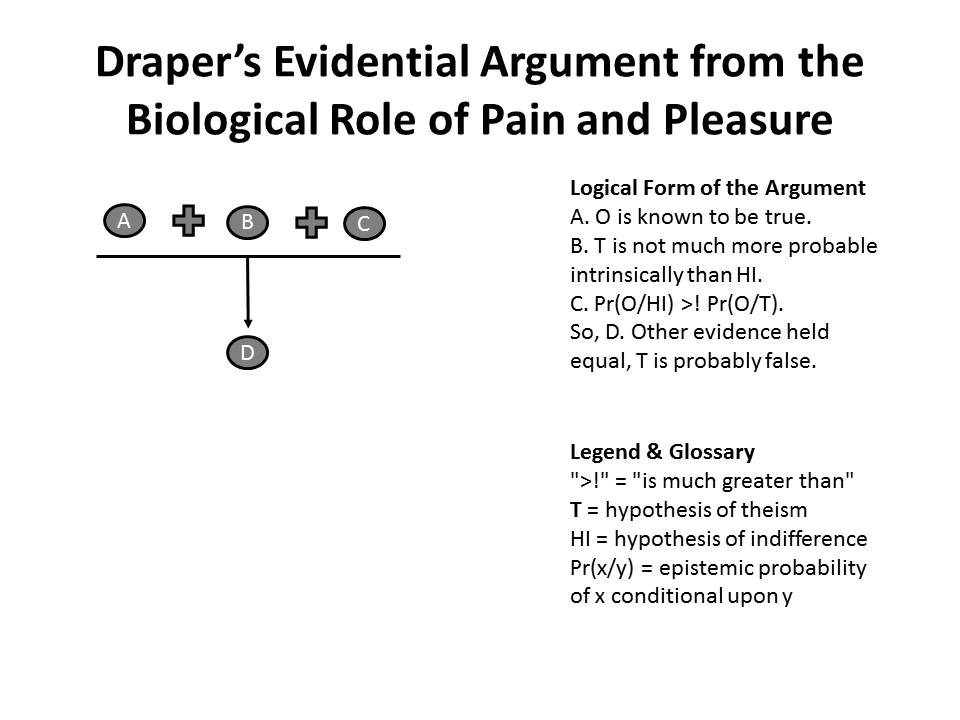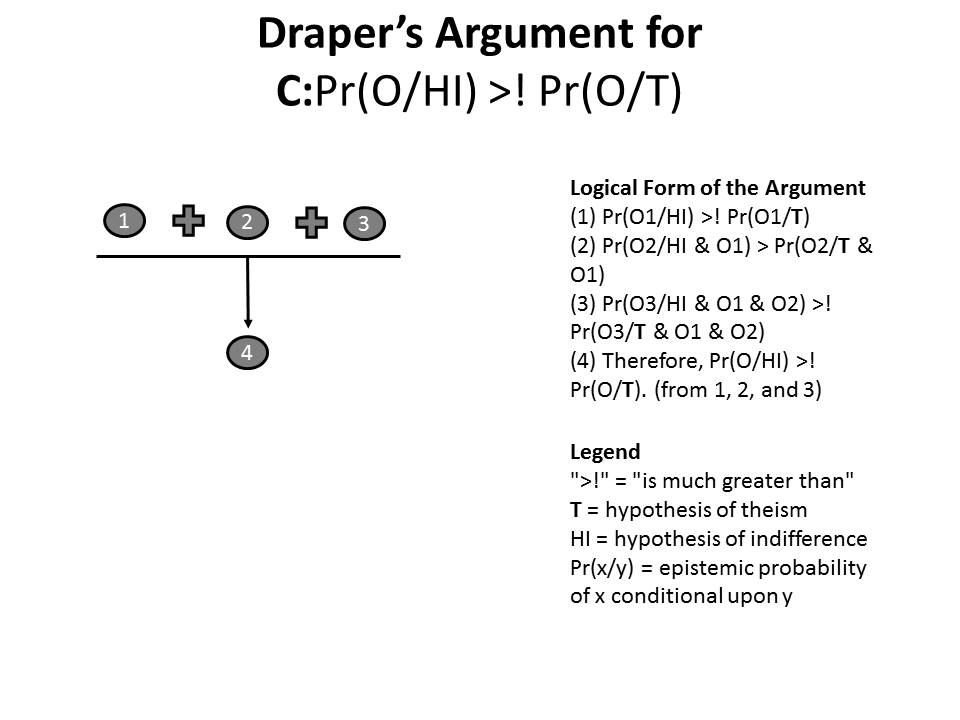Draper on Pain and Pleasure: Part One
The academic journal Nous published an article by Paul Draper in 1989 on the evidential argument from evil. (The article used to be available online for free but is now only available behind a paywall at JSTOR.) The article is now widely regarded as a ‘classic’ in the contemporary literature on the problem of evil; it has been republished in numerous anthologies and readers.
In this part, I’ll summarize the terminology he uses and provide a basic overview of the argument’s logical structure or form. Note that, unless otherwise indicated, all quotations inside quotation marks (“) are quotations of Draper’s article.
1. Terminology, Symbols, and Key Concepts
Before we begin, we need to be clear on how Draper uses the key terminology in his argument.
hypothesis: a proposition which we do not know with certainty to be true or false
theism (T): the hypothesis that “there exists an omnipotent, omniscient, and morally perfect person who created the Universe.”
hypothesis of indifference (HI): the proposition that “neither the nature nor the condition of sentient beings on earth results from benevolent or malevolent actions performed by supernatural persons.” Note that HI is logically consistent with both supernaturalism and naturalism. Furthermore, note that HI is logically incompatible with T.
goal-directed: “a system S is ‘goal-directed’ just in case some property G that S has exhibited or will exhibit, a broad range of potential environmental changes are such that:
(i) if they occurred at a time when S is exhibiting G and no compensating changes took place in the parts of S, then S would cease to exhibit G and never exhibit G again,
(ii) if they occurred at t a time when S is exhibiting G, then compensating changes would take place in the parts of S, resulting in either S’s continuing to exhibit G or in S’s exhibiting G once again.”
biological goals: “the goals to which organic systems are directed.”
biologically useful: “a part of some goal-directed organic system S is ‘biologically useful’ just in case:
(i) it causally contributes to one of S’s biological goals (or to one of the biological goals of some other goal-directed organic system of which it is a part), and
(ii) its doing so is not biologically accidental.”
biologically gratuitous: pain and pleasure that is not biologically useful.
O: a statement about “the kinds, amounts, and distribution of pain and pleasure in the world.” O is the conjunction (combination) of the following statements:
O1: a statement about facts about “moral agents experiencing pain or pleasure that we know to be biologically useful;”
O2: a statement about facts about “sentient beings that are not moral agents experiencing pain or pleasure that we know to be biologically useful;” and
O3: a statement about facts about “sentient beings experiencing pain or pleasure that we do not know to be biologically useful.”
“>!”: much greater than
epistemic probability: “Relative to K, p is epistemically more probable than Q, where K is an epistemic situation and p and q are propositions, just in case any fully rational person in K would have a higher degree of belief in p than in q.” Note that epistemic probabilities can “vary from person to person and from time to time, since different persons can be in different epistemic situations at the same time and the same person can be in different epistemic situations at different times.”
Pr(x): the epistemic probability of X.
Pr(x | y): the epistemic probability of x conditional upon y, viz., the epistemic probability that proposition X is true, on the assumption that proposition y is true.
2. The Argument’s Logical Structure
Draper’s 1989 classic article really has two arguments, which I will summarize in reverse order. The second argument is his evidential argument from evil. That argument is the argument where he argues that the biological role of pain and pleasure is prima facie evidence against theism. Draper did not explicitly state the logical form of his argument in his 1989 article, but he did in a later article. He states the argument as follows.
A. O is known to be true.
B. T is not much more probable intrinsically than HI.
C. Pr(O/HI) >! Pr(O/T).
So, D. Other evidence held equal, T is probably false.
Note that while the above argument implies that we have a good prima facie reason to believe that T is probably false (since T and HI are incompatible), it does not imply that we have a good prima facie reason to believe that HI is true (since T and HI are not jointly exhaustive and so both could be improbable). So the argument from the biological role of pain and pleasure could be more accurately described as an argument against T than as an argument for HI, though of course in some sense it is both.
Let’s turn, then, to Draper’s first argument. Draper’s first argument, which was the focus of his 1989 article, is his argument for the truth of C. Since O is logically equivalent to O1 & O2 & O3, Draper observes that we can use the chain rule to measure the evidential impact of O upon any generic hypothesis h:
Pr(O/h) = Pr(O1 & O2 & O3/h)= Pr(O1/h) x Pr(O2/O1 & h) x Pr(O3/O1 & O2 & h)
By substituting h with “HI” and “T” we get the following statements, respectively:
(a) Pr(O/HI) = Pr(O1/HI) x Pr(O2/O1 & HI) x Pr(O3/O1 & O2 & HI)
(b) Pr(O/T) = Pr(O1/T) x Pr(O2/O1 & T) x Pr(O3/O1 & O2 & T)
Draper’s strategy for showing that Pr(O / HI) is much greater than Pr(O / T) is to show that “each of the multiplicands” on the right-hand side of (a) is “either greater or much greater than the corresponding multiplicand” of (b). Thus, his first argument goes like this.
(1) Pr(O1/HI) >! Pr(O1/T)
(2) Pr(O2/HI & O1) > Pr(O2/T & O1)
(3) Pr(O3/HI & O1 & O2) >! Pr(O3/T & O1 & O2)
————————————————————————-
(4) Therefore, Pr(O/HI) >! Pr(O/T). (from 1, 2, and 3)
Obviously, to make both arguments in any way compelling, Draper needs to support the premises of both arguments. We’ll look at the support for those premises in future posts.


